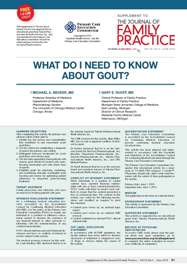User login
Gout is a chronic, often silent disorder in its early stages that is punctuated by acute, extremely painful arthritic flares. Over time, untreated or insufficiently treated gout may progress, with more frequent flares and formation of urate crystal deposits (tophi) and associated chronic, deforming arthritis (gouty arthropathy). One major aim in the management of gout is to treat the pain of acute flares aggressively with anti-inflammatory agents to reduce flare intensity and duration. This CME supplement discusses the risk factors and comorbidities that contribute to and exacerbate acute gout flares, the criteria for establishing a diagnosis of gout and how to establish goals for achieving, sustaining, and monitoring clinically meaningful urate lowering and means for optimizing patient adherence to long-term urate-lowering treatment.
Gout is a chronic, often silent disorder in its early stages that is punctuated by acute, extremely painful arthritic flares. Over time, untreated or insufficiently treated gout may progress, with more frequent flares and formation of urate crystal deposits (tophi) and associated chronic, deforming arthritis (gouty arthropathy). One major aim in the management of gout is to treat the pain of acute flares aggressively with anti-inflammatory agents to reduce flare intensity and duration. This CME supplement discusses the risk factors and comorbidities that contribute to and exacerbate acute gout flares, the criteria for establishing a diagnosis of gout and how to establish goals for achieving, sustaining, and monitoring clinically meaningful urate lowering and means for optimizing patient adherence to long-term urate-lowering treatment.
Gout is a chronic, often silent disorder in its early stages that is punctuated by acute, extremely painful arthritic flares. Over time, untreated or insufficiently treated gout may progress, with more frequent flares and formation of urate crystal deposits (tophi) and associated chronic, deforming arthritis (gouty arthropathy). One major aim in the management of gout is to treat the pain of acute flares aggressively with anti-inflammatory agents to reduce flare intensity and duration. This CME supplement discusses the risk factors and comorbidities that contribute to and exacerbate acute gout flares, the criteria for establishing a diagnosis of gout and how to establish goals for achieving, sustaining, and monitoring clinically meaningful urate lowering and means for optimizing patient adherence to long-term urate-lowering treatment.
